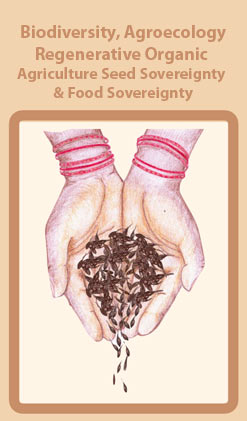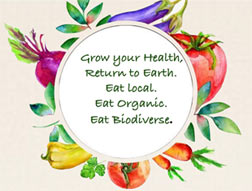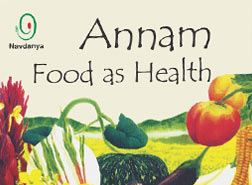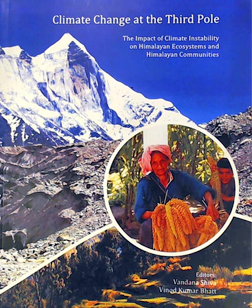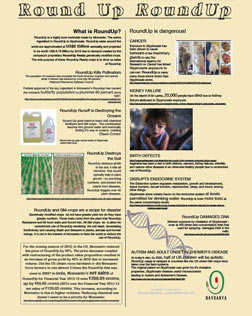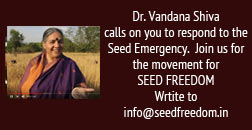Today, we are faced with two crises on a planetary scale - climate change and species extinction. Our current modes of production and consumption - starting with the industrial revolution and aggravated by the advent of industrial agriculture, have contributed to both these crises. These are termed, by the scientists who have been studying climate change, as anthropogenic emissions - originating from human activity. If no action is taken to reduce greenhouse gases, we could experience a catastrophic 4°C increase in temperatures by the end of the century.
Climate change is not just about global warming but it is leading to the intensification of droughts, floods, cyclones and other extreme weather events. Year after year frequency of these extreme events is increasing which is a matter of big concern for the entire humanity.
Industrial agriculture and a globalised food system are responsible for 40% of all green house gas emissions. Chemical monocultures are also more vulnerable to failure in the context of an unstable climate. Industrial, chemical monocultures, along with our globalised food system are directly contributing to climate change to a horrific extent. A report from grain based in Barcelona Spain in their report on Food Sovereignty concludes “that the current global food system, propelled by an increasingly powerful transnational food industry, is responsible for about half of all human produced greenhouse gas emissions: anywhere between a low of 44 per cent to a high of 57 per cent.” https://www.grain.org/ article/entries/5390-food-sovereignty-can-stop-climate-change-and-feed-us-all.
The spread of monocultures and the increasing use of chemical fertilisers in agriculture, combined with destruction of habitats, have contributed to the loss of biodiversity. Paradoxically, this biodiversity would have helped sequester greenhouse gases. Three years after Rio, the United Nations Leipzig Conference on Plant Genetic Resources assessed that 75% of the world’s biodiversity had disappeared in agriculture because of the Green Revolution and industrial farming. The FAO estimates, 70-90% of global deforestation is due to Industrial Agriculture pushing it’s monocultures further and further into forests to grow commodities for export - not for food. Disappearance of pollinators and beneficial soil organisms are other dimensions of biodiversity erosion due to industrial agriculture.
A transition to biodiversity-intensive, ecologically-intensive agriculture addresses both the climate crisis and the biodiversity crisis simultaneously, while also addressing the food crisis. Even though industrial agriculture is a major contributor to climate change and more vulnerable to it, there is an attempt by the Biotechnology industry to use the climate crisis as an opportunity to further push GMOs, and to deepen their monopoly on global seed supply, through biopiracy-based patents on climate resilient seeds, that were bred by farmers over generations. Climate resilient traits will become increasingly important in times of climate instability and in the current system, will allow corporations to exploit the farmers and consumers by owning the rights to these plants.
Intergovernmental Panel on Climate Change (IPCC) has recognized that since 1750 the net effect of human activities on the earth’s climate has been one of warning. Certainly about the anthropogenic basis for climate change has gone from greater than 66 percent to greater than 90 percent.
New research published on 2nd March, 2016 in The Lancet finds that by making food less available, climate change could account for more than 500,000 human deaths by the year 2050. The researchers assumed a scenario where global air temperature in 2050 is about 2 degrees warmer than it was between 1986 and 2005. According to the research where agriculture is crippled by more drought, heat, and flooding, each person would see 3.2 percent less food on their plates every day overall. In addition, by 2050, under that same climate change scenario, we can anticipate the average person will eat 4 percent fewer fruits and vegetables. http://www.newsweek.com/climate-change-leads-500000-deaths-altering-food-production-433182.
Navdanya's work on climate change shows that efforts that mitigate climate change not only contribute to adaptation but also contribute to climate and ecological justice. Our three areas of focus are -
Climate Change and Agriculture
Climate Change in the Himalaya
Climate Change, Biodiversity and Agriculture
Today, we are faced with two crises on a planetary scale - climate change and species extinction. Our current modes of production and consumption - starting with the industrial revolution and aggravated by the advent of industrial agriculture, have contributed to both these crises. These are termed, by the scientists who have been studying climate change, as anthropogenic emissions - originating from human activity. If no action is taken to reduce greenhouse gases, we could experience a catastrophic 4°C increase in temperatures by the end of the century.
Climate change is not just about global warming but it is leading to the intensification of droughts, floods, cyclones and other extreme weather events. Year after year frequency of these extreme events is increasing which is a matter of big concern for the entire humanity.
Industrial agriculture and a globalised food system are responsible for 40% of all green house gas emissions. Chemical monocultures are also more vulnerable to failure in the context of an unstable climate. Industrial, chemical monocultures, along with our globalised food system are directly contributing to climate change to a horrific extent. A report fromgrain based in Barcelona Spain in their report on Food Sovereignty concludes “that the current global food system, propelled by an increasingly powerful transnational food industry, is responsible for about half of all human produced greenhouse gas emissions: anywhere between a low of 44 per cent to a high of 57 per cent.” https://www.grain.org/ article/entries/5390-food-sovereignty-can-stop-climate-change-and-feed-us-all.
The spread of monocultures and the increasing use of chemical fertilisers in agriculture, combined with destruction of habitats, have contributed to the loss of biodiversity. Paradoxically, this biodiversity would have helped sequester greenhouse gases. Three years after Rio, the United Nations Leipzig Conference on Plant Genetic Resources assessed that 75% of the world’s biodiversity had disappeared in agriculture because of the Green Revolution and industrial farming. The FAO estimates, 70-90% of global deforestation is due to Industrial Agriculture pushing it’s monocultures further and further into forests to grow commodities for export - not for food. Disappearance of pollinators and beneficial soil organisms are other dimensions of biodiversity erosion due to industrial agriculture.
A transition to biodiversity-intensive, ecologically-intensive agriculture addresses both the climate crisis and the biodiversity crisis simultaneously, while also addressing the food crisis. Even though industrial agriculture is a major contributor to climate change and more vulnerable to it, there is an attempt by the Biotechnology industry to use the climate crisis as an opportunity to further push GMOs, and to deepen their monopoly on global seed supply, through biopiracy-based patents on climate resilient seeds, that were bred by farmers over generations. Climate resilient traits will become increasingly important in times of climate instability and in the current system, will allow corporations to exploit the farmers and consumers by owning the rights to these plants.
Intergovernmental Panel on Climate Change (IPCC) has recognized that since 1750 the net effect of human activities on the earth’s climate has been one of warning. Certainly about the anthropogenic basis for climate change has gone from greater than 66 percent to greater than 90 percent.
New research published on 2nd March, 2016 in The Lancet finds that by making food less available, climate change could account for more than 500,000 human deaths by the year 2050. The researchers assumed a scenario where global air temperature in 2050 is about 2 degrees warmer than it was between 1986 and 2005. According to the research where agriculture is crippled by more drought, heat, and flooding, each person would see 3.2 percent less food on their plates every day overall. In addition, by 2050, under that same climate change scenario, we can anticipate the average person will eat 4 percent fewer fruits and vegetables. http://www.newsweek.com/climate-change-leads-500000-deaths-altering-food-production-433182.


